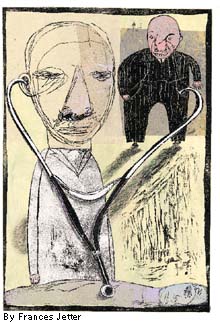
The changing challenges of medical ethics got poked and prodded and poked some more at a recent conference co-sponsored by Penn’s Center for Bioethics.
By John Shea |Illustration by Frances Jetter
“Orthodoxies need heresies,” said Dr. Paul Root Wolpe, C’79, peering over the lectern into the rather orthodox-looking audience of physicians, historians, bioethicists, and lawyers assembled in Philadelphia’s Ritz-Carlton Hotel. Wolpe, a senior faculty associate at Penn’s Center for Bioethics, explained: Orthodoxies strive to keep the heresies — the alternatives — “marginalized but alive.” And if the heretics come up with a good feature, you do what all great systems do: “you can co-opt it.”
Many in the large conference hall laughed; but whether some of it was the laughter of rueful recognition was difficult to tell. His audience, after all, was there as part of the celebrations for the American Medical Association’s sesquicentennial. By virtue of surviving 150 years and in fact flourishing after some trying times, the AMA could certainly be described as the orthodoxy in the diverse field of health care. And here was Wolpe — whose opening words were “I know I’m going to get myself in trouble” — delivering a somewhat irreverent exegesis of the AMA’s scripture.
The theme of the recent conference, cosponsored by the Center for Bioethics, was “Ethics and American Medicine: History, Change, and Challenge.” Its focus was the AMA’s code of medical ethics — born, like the association itself, 150 years ago. According to the AMA’s president, Dr. Daniel H. Johnson Jr., the professional code of ethics “is the common bond that has linked all physicians over the years, from Hippocrates to today’s first-year medical residents.” Yet what Wolpe and other speakers with a historical perspective were suggesting is that the bond has often been strained if not shattered.
Dr. Charles E. Rosenberg, chairman of the Department of the History and Sociology of Science at Penn, emphasized that the codes of every society reflect its values. What the ethics code of 1847 reveals, he added, is a world in which most practitioners worked alone, saw their patients in their homes and not in an institutional setting, and delivered “continuity of care.” But it was also a world of “often brutal rivalry for the patronage of a less than adequate supply of fee-paying patients.”
In such a context, it is not hard to see the antagonism that Wolpe described between the “regulars” (the orthodox physicians who might be drawn to the fledgling AMA) and “alternatives” (the practitioners of alternative medicine such as homeopathy) as part of a larger “brutal rivalry.”
According to Wolpe, who is also an adjunct assistant professor of sociology at Penn, science has traditionally been used by the American medical profession as a weapon to denigrate and exclude alternative models of healing; in denigrating their competition, the regulars painted all alternatives as unscientific. The irony, said Wolpe, is that many of the regulars’ treatments from the 18th and 19th centuries are seen to have little scientific validity today. He quoted Oliver Wendell Holmes (1809-94), the author and physician, who said that much of the period’s medicine should be sunk to the bottom of the sea: “it would be all the better for mankind — and worse for the fishes.”
The regulars, after all, bled their patients, sometimes to death, and used blistering, puking, purging, cupping, and poisonous doses of mercury and arsenic. At least, claimed Wolpe, the homeopaths — whose system of medicine treated disease by administering minute doses of a remedy that, in healthy persons, would produce symptoms of the disease being treated — did their patients far less harm. And by the standards of the day, homeopaths and some eclectics were no less scientific than the orthodox practitioners, testing effects and taking scrupulous notes.
Even as orthodox medicine is dismissing alternatives, Wolpe suggested, it is drawing heavily from them, is profoundly influenced by them, and is changing its therapeutics because of models tried out by them. In the 19th century, the regulars began to absorb “the kinder, gentler therapies” practiced by the alternatives. Similarly, in the last few decades, Wolpe sees evidence that orthodox medicine has accepted much from the very alternatives it was officially rejecting: the importance of nutrition and dietary and vitamin supplements; ideas to reduce stress; exercise as part of a reasonable medical regimen; yoga; and massage.
In recent years, for example, the state of Washington passed a law mandating coverage of alternative care; conventional doctors and “naturopaths” have worked side by side in clinics; and more than 30 medical schools in the country are now offering courses in alternative medicine. (Penn, in fact, is offering a new course this term on “complementary medicine.”)
The AMA’s official view today is that ethical practitioners hold one precept above all others: “doing what is best for patients.” But that precept, said Johnson, the AMA president, is now under attack, “as the business of health care and new medical technologies challenge our commitment to long-standing ethical principles.”
The business of health care today featured prominently in the cases cited by attorney Kirk B. Johnson, group vice-president for health-policy advocacy and general counsel to the AMA. He told of a Dr. Zamora, recruited by a Texas-owned HMO that runs clinics in the poor neighborhoods of San Antonio. Zamora saw one elderly patient complaining of pain who had been told she had arthritis and that “she would have to learn to live with it.” When Zamora examined her, however, he found she had five fractured ribs. But when he asked that she be admitted to the hospital, his request was denied, and he was told his salary could be reduced.
Another patient of his — a woman with a family history of breast cancer — had been unable to get a mammogram from the clinic. Zamora arranged for her to have one; the test showed that she needed a radical mastectomy. Within six months, Zamora was terminated by the clinic because of his complaints and his refusal to follow the clinic’s orders. And when he returned to his office to retrieve a telephone number of “a patient about whom he had particular concerns,” he was slapped with a $1 million lawsuit. The charge? Civil trespass and violation of the covenant not to compete. The Texas chapter of the AMA is suing on Zamora’s behalf.
Today, there are plenty of cases in which doctors are not willing to “do what is best for patients.” Other ethical challenges include: inadequate care of dying patients; abortion; disciplining of incompetent doctors; physician-assisted suicide; experiments with human embryos; and informed consent by patients.
The emotional charge in some of these issues was underscored by a small group of demonstrators who picketed the conference, protesting the AMA’s position on mandatory HIV testing of pregnant women and newborns. The protesters were concerned that the information gathered through such tests could be used in a discriminatory manner, and although the AMA’s position urges the greatest degree of patient confidentiality except when absolutely necessary for reasons of public health, the demonstrators were not reassured.
Ironically, at roughly the same time the demonstrators were picketing outside the Ritz-Carlton, Dr. Francis Collins, director of the National Center for Human Genome Research, was inside raising the same issue. “Our medical-records situation today is a joke!” he said; “one hundred different people” can look at an individual’s records. This “pillar” of privacy, he argued, desperately needs shoring up.
Some of the AMA’s successes in the 20th century were built on the assumptions of the 1847 code, said Dr. Rosemary A. Stevens, professor of the history and sociology of science at Penn and author of In Sickness and in Wealth: American Hospitals in the 20th Century. Yet for much of the intervening period, the AMA seemed out of step with the major trends in medicine, such as the development of specialties, institutions, and third-party payments. As Stevens presented it, the animosity between general practitioners and the burgeoning specialists was comparable to that between the regulars and the practitioners of homeopathy.
One president of the AMA in the 1890s, she recounted, claimed that the specialist “could see no further than the organ he has selected as his special plum.” The profession’s leaders, who were then “upgrading the standards of the medical schools around specialized departments, were scathing and contemptuous of the army of ill-trained, often mercenary specialists that thronged the cities by 1900. Leading surgeons estimated in 1906 that 30 percent of gynecological operations were unnecessary; that the vogue for doing cesarean sections was a ‘serious menace’; and that statistics did not support many of the radical operations being done for cancer of the uterus.”
The task for physicians in 1997, Stevens argued, is very different from that of 1847 or 1900. Yet despite — or perhaps because of — the new challenges, there is an opportunity to “redefine the ideal physician.”
“What difference does ethics make?” asked Dr. Arthur L. Caplan, director of Penn’s Center for Bioethics. Given the clamor over the first cloning from an adult animal earlier this year — “a complete hyperventilation of a society over a particular scientific experiment,” as Caplan phrased it — the question can be put another way: can ethics offer a framework for understanding what has happened and for taking action?
There is time for society to act to prevent human cloning if it so desires, Caplan argued. But he also believes that society must gain a better understanding of science and medicine. “What nuts do in the basement has nothing to do with the mainstream development of cloning,” he said. If the federal government does not fund mainstream research into cloning, he continued, “postdocs and graduate students will not study it.”
“Mainstream science can police itself when it chooses,” said Caplan. The matter of physician-assisted suicide and Dr. Kevorkian, against whom he has testified, is not an exception: “The dirty little secret of Dr. Kevorkian is that the citizens of Michigan chose not to pass a law to stop him — that’s why he continues. If they didn’t want it, they would stop it.” On the other hand, the experiments of Nazi doctors at Dachau, he argued, could not happen today.
Caplan also gave a recent example of “a renegade scientist” at George Washington University whose work with human embryos was halted after it was discovered that he had misled the university’s institutional review board. A number of other projects — the Baby Fay baboon transplants, anencephalic babies as organ donors, embryo research, the use of fetal tissue from aborted fetuses for transplant — have been stopped, said Caplan, “because of moral criticism.”
Francis Collins took aim at the concept of human cloning on both scientific and moral grounds. Despite the example of Dolly the Scottish sheep, he said, human biology is different and may not work the same way; there was massive fetal loss in the experiments that produced Dolly; and experiments with humans would produce mutations, as well as an enormous degree of risk of genetic disease. All in all, he said, it was “a repugnant scenario” that should be rejected.
More pressing, Collins suggested, are the legal and ethical questions surrounding genetic testing. One is the use of genetic information by insurance firms, which might refuse coverage for someone with a susceptibility, say, to breast cancer. Another is that of unequal wealth and access to medical care.
Charles Rosenberg offered some hope for today’s medical practitioners as they try to reformulate a relevant ethical code. The crisis they face, he said, is one of “defining balance between medicine as humane caring, as applied science, as marketplace actor, and — more recently — as object of public policy.” The single most important element of the old code, the “doctor-patient dyad,” should remain central, he said, but that relationship must be broadened beyond the patient’s bedside.
The AMA’s original code prohibited secret medications and patents — an issue that still resonates, according to Dr. Eliot Friedson, emeritus professor of sociology at New York University, since more and more treatments and discoveries are being claimed as private property. Even communication among scientists engaged in research that may benefit humanity has become more limited because of the competition for prizes and profits. Ironically, the form of communication that has increased dramatically is advertising — whose aim is to exaggerate the positive aspects of a drug, a treatment, or a health system and play down risks. As a result, Friedson argued, advertising can seriously undermine health. (Underscoring his point was a display in the lobby of advertisements for some of the dubious products that the AMA has attacked over the years. One was the Evans Vacuum Cup from about 1905: looking like a Flash Gordon helmet with wires, it was described by the makers as “A Scientific Method of Growing Hair.”)
The highest level of health care has outstripped the society’s ability to pay, argued Dr. Robert M. Tenery, vice chair of the AMA’s Council on Ethical and Judicial Affairs. Where should the health-care dollars be spent: in the last three months of life, where most of them currently go, or in the first three months, where Tenery and others feel they would do much greater good?
Despite the fact that the United States is the world leader in health care, Tenery said, at any one time, there are from 43 to 45 million Americans uninsured. And one-third of children under the age of two are still inadequately immunized. The nation’s medical priority, he argued, should be to make affordable coverage more accessible.
The proper use of resources was also raised by Alexander Morgan Capron, the University Professor of Law and Medicine at the University of Southern California. While urging a greater consideration of patients’ rights, he worried that patient-dissatisfaction with managed care could be unwisely exploited. When it comes to health care, he said, patients want everything. They want a situation “where the normal checks of the marketplace do not apply.”
Yet Capron acknowledged that the public has a right to be skeptical of doctors’ claims of ethical behavior. After all, there is profit in health care; Capron cited studies showing a huge increase in doctors’ income since the 1960s. Physicians, he said, must forswear some profit if they want to reclaim the role of prophet.
Wrapping up the conference was George J. Annas, chair of the health-law department at Boston University. Harking back to the effective interaction of physicians and lawyers in successfully prosecuting Nazi doctors, Annas announced the formation of Global Lawyers and Physicians: “Working Together for Human Rights.”
The AMA also announced a new Institute for Ethics, to be headed by Dr. Linda L. Emanuel, formerly assistant director of medical ethics at Harvard. Its first initiative is to instruct America’s physicians on providing better care to dying patients. “We want to change the culture of medical practice around end-of-life care,” said Emanuel, promising conferences, workshops, and direct dissemination of educational materials to practicing physicians.
Emanuel’s revelation that the institute plans to release “ethics report cards” for all organizations involved in health care was greeted with satisfaction. At the press conference announcing the institute, Caplan praised the new staff as “tough-minded people who can prod and agitate.” In other words, ethics … with teeth.
DR. JOHN R. SHEA, Gr’84, is the Editor of Penn Health, a magazine for employees of the Penn Health System.




